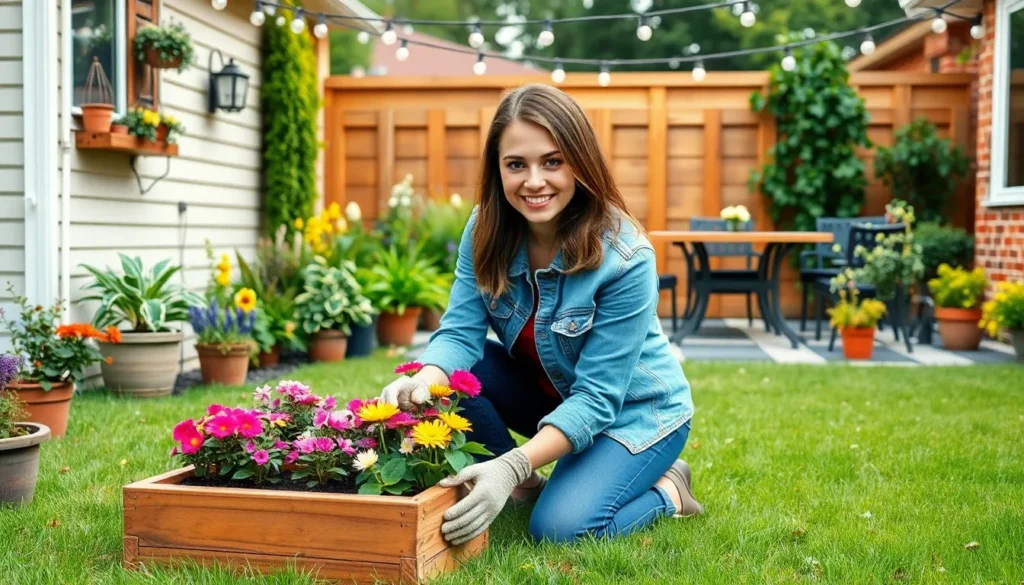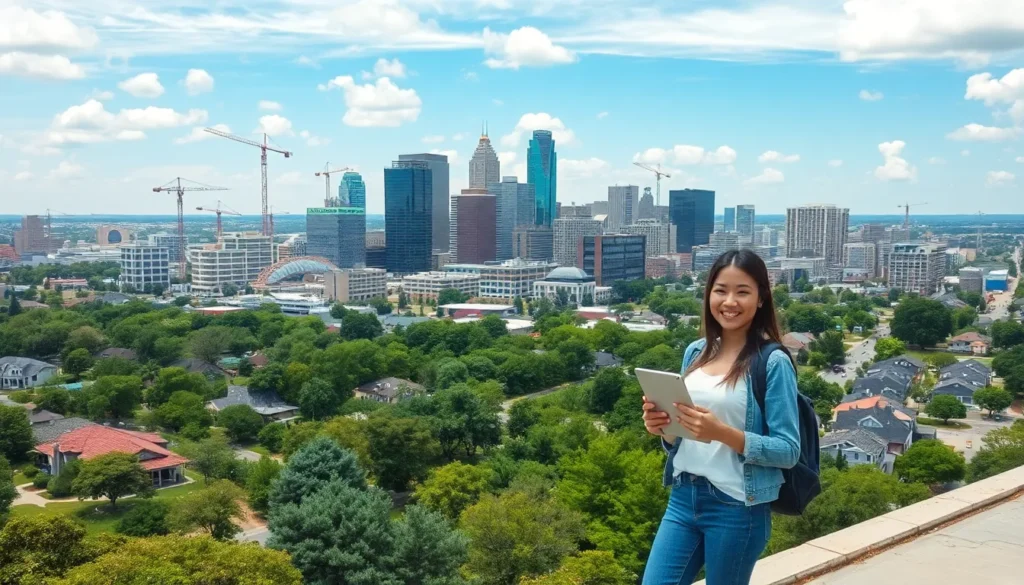Imagine sipping your favorite iced tea on a hot summer day, while a gentle breeze rustles the leaves above. Shade trees for patios aren’t just a nice-to-have; they’re a game-changer for outdoor living. These leafy giants not only provide relief from the blazing sun but also add a touch of elegance to any space. Who wouldn’t want to transform their patio into a cool oasis?
Choosing the right shade tree can feel like dating—there’s a lot to consider! From size and growth rate to maintenance needs, finding the perfect match can be a bit overwhelming. But fear not! With the right guidance, you’ll discover trees that not only suit your patio but also make your neighbors green with envy. Let’s dive into the world of shade trees and find the ideal companion for your outdoor retreat.
Table of Contents
ToggleBenefits of Shade Trees for Patio
Shade trees enhance patio experiences by providing comfort and style. Their advantages encompass temperature control and aesthetic appeal.
Temperature Control
Trees offer significant relief from heat by lowering ambient temperatures. They create a microclimate that leads to cooler outdoor spaces. Shade reduces the demand for air conditioning, conserving energy and lowering bills. In fact, research shows that shaded patios can be up to 20 degrees cooler than unshaded areas. This temperature control encourages longer outdoor gatherings, making patios more enjoyable.
Aesthetic Appeal
Having shade trees adds natural beauty to patios. They introduce diverse colors and textures, enhancing landscaping. Different species, such as maples or oaks, contribute unique characteristics. Such greenery also attracts wildlife, enriching the outdoor environment. A well-placed tree can serve as a focal point, improving overall design. Patios surrounded by trees become inviting retreats, perfect for relaxation and socializing.
Types of Shade Trees for Patio
Selecting the right type of shade tree significantly impacts the comfort and aesthetics of a patio. Two primary categories of shade trees stand out: deciduous trees and evergreen trees.
Deciduous Trees
Deciduous trees offer seasonal beauty with their vibrant foliage. These trees shed leaves in autumn, allowing sunlight during winter months. Examples include the Maple and Oak, providing dense canopies that reduce summer heat effectively. Growth rates vary; some like Red Maples grow quickly, while others such as Sugar Maples thrive slowly. Maintenance requirements differ as well, with most needing regular pruning to ensure a healthy structure. Homeowners appreciate their ability to create dramatic seasonal changes.
Evergreen Trees
Evergreen trees maintain their foliage year-round, providing consistent shade. These trees such as Pine and Spruce offer shelter and privacy, making them ideal for patio settings. Some evergreens can grow rapidly, while others take time to mature. Many require less maintenance than deciduous varieties, producing minimal leaf litter. Their year-round greenery creates a lush, inviting atmosphere. Evergreens also serve as windbreaks, enhancing outdoor comfort, making patios more enjoyable throughout the seasons.
Factors to Consider When Choosing Shade Trees
Choosing shade trees for a patio involves careful consideration of several important aspects that align with specific outdoor needs.
Space and Size Requirements
Space availability plays a critical role in tree selection. Trees should fit comfortably into the designated area without overwhelming the patio. Mature height and spread determine how much area a tree will occupy, and trees like Red Maple thrive in spacious settings, whereas smaller varieties, such as Japanese Maple, suit limited spaces. Ensuring the tree doesn’t obstruct views or interfere with structures enhances overall aesthetics. Additionally, consideration of root systems prevents potential damage to nearby foundations or paving.
Local Climate and Soil Conditions
Climate conditions significantly influence tree health and growth. Shade trees like Sweetgum flourish in warmer regions, adapting well to heat and humidity. Soil type, including drainage and nutrient content, also impacts tree performance; trees like Oak prefer well-drained soils, while others thrive in loamy or clay-rich environments. Assessing local rainfall patterns and temperature variations informs tree choices to match specific site conditions effectively. Understanding these factors helps establish a thriving patio environment that maximizes shade benefits.
Maintenance Tips for Patio Shade Trees
Maintaining shade trees enhances their growth and the comfort of a patio. Regular care ensures these trees thrive while providing optimal shade and aesthetic appeal.
Pruning Techniques
Pruning encourages healthy growth in shade trees. Start by removing dead or damaged branches to improve airflow and light penetration. Utilize clean, sharp pruning tools to avoid damaging the tree. Timing is crucial; perform pruning in late winter or early spring before new growth begins. Additionally, shaping the tree enhances its form, providing a balanced appearance suitable for patio spaces. Regular checks for pests or diseases during pruning can help maintain overall tree health.
Watering and Fertilization
Water management plays a key role in shade tree maintenance. Established trees typically require deep watering every two to three weeks during dry spells. Ensuring moisture reaches the root zone supports healthy development. Fertilizing helps replenish nutrients, promoting robust growth. Select a balanced, slow-release fertilizer and apply it in early spring or late fall. Observing tree response to watering and fertilizer adjustments can lead to improved health and an inviting patio atmosphere.
Conclusion
Choosing the right shade tree can transform a patio into a serene retreat. With the right selection, homeowners can enjoy cooler temperatures and enhanced aesthetics while creating an inviting space for relaxation and social gatherings.
Deciding between deciduous and evergreen trees depends on personal preferences and local conditions. Understanding maintenance needs and growth patterns ensures that the chosen tree thrives and complements the patio environment.
By investing time in selecting and caring for shade trees, individuals can enjoy the numerous benefits these natural elements provide. A well-chosen shade tree not only elevates the outdoor experience but also contributes to the overall beauty and comfort of the home.













